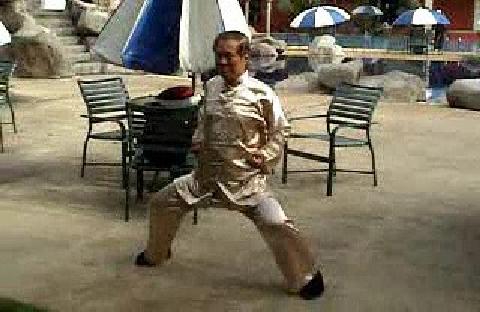PRACTICING KUNGFU FOR HEALTH

The Horse-Riding Stance
Question
If our aim is just for health and not for fighting, why do we practice kungfu instead of just chi kung?
— Rafael, Colombia
Answer
Your question reminds me of my oldest student, Robert Trout. He asked me why I was so healthy? I told him that I practiced chi kung. "I also practice chi kung," he said, "but why I am not as healthy as you?"
His question really set me thinking. I replied, "I also practice kungfu." Two years later, Robert, who was 87 years old then, traveled half the globe to learn kungfu from me. I remember I taught him to stand on one leg which he did quite well.
Having good health is the climax of chi kung, but it is only the starting point of kungfu. A chi kung teacher will consider he has accomplished his aim when his students are healthy. A kungfu teacher ensures his students are healthy first before they start kungfu. This difference in the levels of health explains why one practices kungfu instead of chi kung even when he leaves aside the issue of combat efficiency.
To have radiant health, one must practice kungfu as a martial art. This, unfortunately, is not the case of kungfu training today. Kungfu training today may be classified into two broad categories -- those who only practice kungfu forms, and those who include free sparring using other martial techniques like Boxing and Taekwondo in their training. If they just practice kungfu forms, or include free sparring using other martial techniques, they may not attain radiant health. Why?
It is practicing kungfu as a martial art that gives radiant health, even when a practitioner may not be interested in fighting. In combat sequence training, for example, he must make quick decisions. When a punch or a kick is aiming at him, if his decision is not quick to ward off or avoid the attack, he will be hit. The aim of combat sequence training is not to be hit at all -- certainly not a generous exchange of blows.
If he is hit, he accepts his own responsibility. He admits that he is slow in his defence or avoiding the attack. He won't say his opponent is too fast. If his opponent is fast, he tries to be as fast as or faster than his opponent, or uses tactics to slow the opponent down.
Successful people remark that it is better to make a wrong decision than to make no decision. In kungfu training, we learn not only to make decisions, but to make fast and right decisions spontaneously.
Another important factor is to be relaxed. The more relaxed a kungfu practitioner is, the better will be his response in sparring. This is possible in good kungfu because internal force is used, which not only enables him to be relaxed but also to be forceful and fast. To be relaxed is also required in chi kung training, but it is in training kungfu as a martial art that to be relaxed is more urgent and demanding.
In our school, kungfu students may spar for hours and remain not tired or panting for breath. This is possible because of internal force. But internal force is not just for kungfu, it is for daily life. A person with internal force will have better results, including better health, than when he did not have internal force as well as other people who do not have internal force. Internal force can also be derived from chi kung practice, but it is in training kungfu as a martial art that more internal force is generated.
Of course, training kungfu as a martial art will enable a practitioner to be combat efficient. But even when his aim is good health and not combat, kungfu training will give him better health.
LINKS
